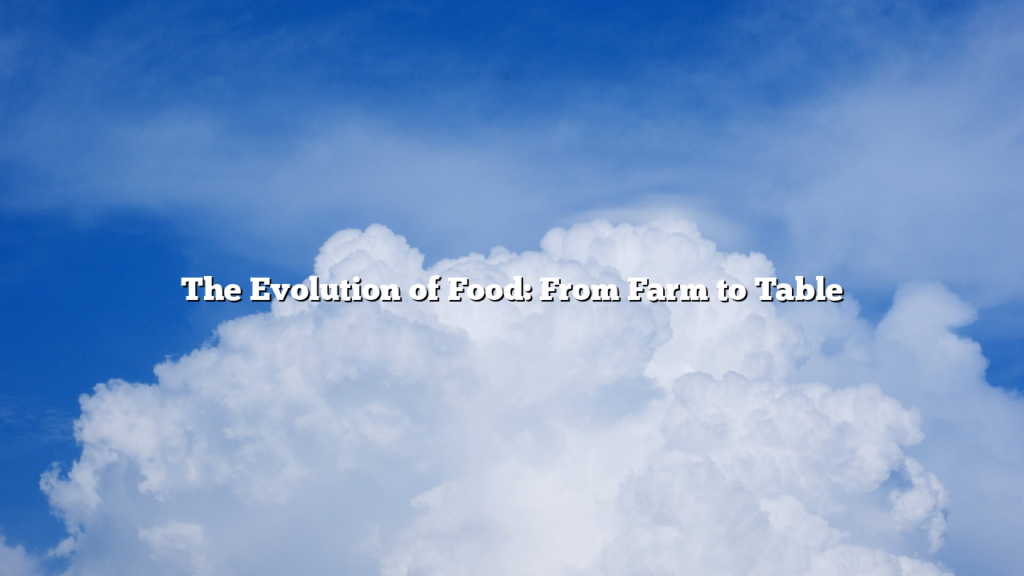
The Evolution of Food: From Farm to Table
Food is much more than sustenance; it is a key part of human culture, tradition, and identity. Throughout history, the way we grow, prepare, and consume food has evolved in response to societal, environmental, and technological changes. What we eat today has roots in centuries of agricultural practices, culinary innovations, and cultural exchanges. This article explores the evolution of food, from its origins on the farm to its modern-day consumption in homes and restaurants worldwide.
The Origins of Food: Early Agriculture and Hunting
The journey of food starts thousands of years ago, during the Agricultural Revolution. Before farming, early humans were hunter-gatherers, relying on wild plants and animals for sustenance. The shift to agriculture around 10,000 BC marked a fundamental change.
People began cultivating crops and domesticating animals, allowing for a more stable and predictable food supply.
The earliest cultivated crops, such as wheat, barley, and rice, became staples in many cultures, laying the foundation for diverse diets around the world. Livestock, including cattle, sheep, and goats, provided meat, milk, and other resources, helping to support the growing populations of early civilizations.
Food was still relatively basic and seasonal during this period, but it was the start of a long journey toward the rich variety of foods we enjoy today. Early agricultural societies developed methods of preserving food, such as drying, salting, and fermentation, allowing them to store food for the leaner months or transport it long distances.
The Rise of Trade and Culinary Diversity
As civilizations advanced, food began to travel. The development of trade routes, such as the Silk Road between Asia and Europe, introduced new ingredients and cooking techniques to different regions. Spices, herbs, and fruits from distant lands began to make their way into kitchens, expanding the flavor profiles of local cuisines.
This era also saw the birth of iconic food traditions. Ancient Greeks and Romans, for example, laid the groundwork for Western cuisine with their emphasis on olive oil, wine, and grain-based dishes. Meanwhile, in China, the cultivation of rice and the use of soy products like tofu were central to daily meals.
One of the most significant contributions to the development of world cuisine was the Columbian Exchange, which took place in the 15th and 16th centuries following Christopher Columbus’s voyages to the Americas. The exchange of crops like tomatoes, potatoes, maize, and cocoa between the New World and the Old World forever transformed food systems across the globe. These ingredients became staples in various cuisines, giving rise to dishes that are now considered quintessential to their respective cultures.
The Industrial Revolution: Mass Production and Food Access
The 18th and 19th centuries marked a dramatic shift in food production with the advent of the Industrial Revolution. Mechanization and mass production made food more accessible and affordable to a wider population. Inventions such as the canning process, refrigeration, and the development of food factories allowed for the mass production and distribution of food.
During this period, many traditional food production methods were replaced by factory-based processes. For example, bread that had once been made by hand in small bakeries became a mass-produced commodity. The industrialization of agriculture also introduced new crops and techniques, such as monocropping, which enabled farmers to grow large quantities of a single crop efficiently.
While industrialization led to an increase in food availability, it also brought challenges. The growing reliance on processed foods, combined with the increased consumption of meat and dairy, led to health concerns, particularly regarding obesity, heart disease, and other
lifestyle-related conditions.
The Rise of Globalization and Convenience Foods
The 20th century saw the rise of globalization, which continued to reshape food systems. With advances in transportation and communication, foods from around the world became more accessible to people in all corners of the globe. Globalization also fostered the development of fast food chains, which brought convenience and speed to the way we eat.
Fast food chains like McDonald’s, Burger King, and KFC became global icons, symbolizing a new era of mass-consumed, standardized food. These chains revolutionized the restaurant industry by offering inexpensive, quick meals that were consistent across locations. They also catered to the increasing pace of modern life, where convenience became a top priority for many consumers.
Alongside the rise of fast food, the development of processed and packaged foods gained momentum. Frozen dinners, canned soups, and snack foods became ubiquitous in homes, making cooking easier but often sacrificing nutritional value. The 20th century also saw the birth of convenience foods like microwavable meals, which further accelerated the trend toward quick and easy eating.
The Contemporary Food Landscape: Sustainability and Health Consciousness
In recent decades, the focus of food production and consumption has shifted towards sustainability and health. As concerns about climate change, environmental degradation, and the depletion of natural resources have grown, there has been a push to make food systems more sustainable. This includes promoting organic farming, reducing food waste, and encouraging plant-based diets.
dewaslot69 -conscious eating has also become a major trend, with consumers increasingly interested in natural and minimally processed foods. Many people are turning to diets that emphasize whole foods, such as fruits, vegetables, whole grains, and lean proteins, while cutting back on processed foods high in sugar, salt, and unhealthy fats. The rise of
vegetarianism, veganism, and flexitarianism reflects a growing awareness of the environmental and health impacts of meat consumption.
At the same time, food innovation is booming. New technologies, such as lab-grown meat, plant-based meat substitutes, and vertical farming, are helping to address the growing demand for food while minimizing environmental impact. The development of alternative proteins, such as algae and insects, could further transform the food landscape in the coming years.
Conclusion
Food is a dynamic and ever-evolving part of human culture. From its humble beginnings as a basic need to its status as a global industry, food has shaped our history, identity, and health. The journey from farm to table has been marked by innovations that have expanded our diets and transformed the way we live. Today, as we face challenges like climate change and health concerns, the future of food will undoubtedly continue to evolve, with sustainability and nutrition at the forefront of the conversation. As we move forward, the way we produce and consume food will play a crucial role in shaping the future of our planet and our
well-being.



